News | October 23rd, 2016

By C.S. Hagen
Photos by Rob Wilson Photography
CANNONBALL – An ancient, bloodless war fuels the Dakota Access Pipeline controversy. It’s a war of words and aged rhetoric; a war of cultures beckoning back the “good old days” of Manifest Destiny and settlers versus the Indians.
Fear the scalp-taking Indian, the Peace Garden State appears to be saying; save the peaceful colonial homesteader. Little is ever mentioned by official sources about the Native Americans’ side of the story. Their version is simply not as important when compared to finishing the USD 3.8 billion, 1,172-mile Dakota Access Pipeline.
Since the Battle of the Greasy Grass, little has changed, according to activists, on how federal and state governments treat Native Americans. Newspapers spread fear, espoused by the law, handed down by politicians who are financially invested into the Bakken oil fields, whose campaigns this election year do those same companies fund, Chase Iron Eyes, the N.D. Democrat Party challenger for U.S. Congress, said.
The U.S. Cavalry never went away, they merely changed uniforms. More than 900 law enforcement officials from 17 counties, 12 cities, and from four states using public funds have been involved in protecting Energy Transfer Partner’s private project.
“We’re choking on hate and nobody seems to care,” camp attorney Angela Bibens said.
The battle for water and land led by the Standing Rock Sioux against DAPL is far from over, and media on both sides of the controversy have woven stories from legends, half-truths, and hearsay. Tempers flare as DAPL nears the Missouri River; journalists riding agendas spread fear, and militarized law enforcement show no pity.
__250-wide.jpeg)
In the beginning there were pipe bombs, which turned out to be ceremonial peace pipes. And then law enforcement reported activists carrying guns, yet no one was arrested. DAPL security personnel from Ohio’s Frost Kennels sprayed mace and urged attack dogs into crowds, resulting in at least half a dozen bites, and yet law enforcement insists activists were the danger. Recently, 30 head of cattle were reported missing, and then three days later mysteriously resurrected by a Sioux County rancher. Two other cows have been found shot in Sioux County, one by bullets, one by arrows, and law enforcement and media are trying to link the crime to activists in the area.
Morton County Sheriff Kyle Kirchmeier repeatedly emphasizes the activists near Standing Rock Sioux Tribe Reservation are dangerous. Activists’ criminal records are being made public, yet no effort has been made to check pipeline workers’ past brushes with the law, which should be swamped with outstanding warrants if the state lives up to its man camp reputation.
Since Saturday morning, 126 more activists were arrested on riot charges along the DAPL pipeline, Morton County Sheriff's Department reported. Two officers were injured, one by his own pepper spray. In total, 269 people have been charged with misdemeanors and felonies since early August.
"Today's situation clearly illustrates what we have been saying for weeks," Kirchmeier said. "That this protest is not peaceful or lawful… This is not about the pipeline. This is not about the protesters. This is about the rule of law."
From the controversy’s start, Morton County Correctional Facility officers have been strip searching – nearly every activist arrested, no matter the charge. Simple misdemeanors to felonies, all are being treated the same.
“It’s a tactic of trying to break you down, and degrade you, make you feel shamed,” Cody Hall said. Hall is the media spokesman for the Red Warriors Camp, and was arrested in early September, held for three days without bail or bond.
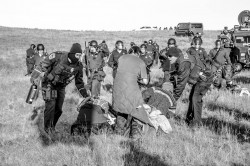
“They have you get naked,” Hall said. “And then he grabbed my genitals and lifted them up, then he said squat, and then he said cough. And then he was looking, when I bent down, he kind of bent down.”
A scare tactic, Hall said. Morton County Correctional Facility reported the strip searches are procedure and in the interest of security.
“The duty correctional officer(s) will conduct a complete visual assessment of prisoners being admitted to insure that the prisoner(s) does not have inadmissible/illegal items on his/her possession before entering a security cell/area of the correctional center,” Morton County Correctional Facility’s guidebook states.
The guidebook continues by stating “admissions procedures will be carried out by correctional staff in a manner which promotes mutual respect rather than one which degrades the prisoner(s) admitted.”
“That’s all I saw it as,” Hall said. “It’s a tactic they were trying to deploy on me, in a way of taking my dignity. You’ll crumble if you don’t have that… dignity.”
Furthermore, an inmate cannot be detained in the holding cell for longer than one hour, although the duty senior correctional officer can make exceptions. Inmates in the holding cell are also allowed to use cell phones, and are closely monitored by duty officers, according to the correctional facility’s guidelines.
Myron Dewey, a filmmaker, was charged with a class-A misdemeanor. Like Hall, he was stripped down, and because he has a ponytail, officers rifled through his hair. He was then put into a visitor’s holding area for three hours, he said. “It was a really small room, barely enough room for one person.”
“Leaving me in that visitor’s area didn’t seem right, they should have put me in the holding cell,” Dewey said. When he went to the courtroom, one of the officers involved in his arrest waited for him in the hallway. “The officer who stole my drone was standing in the hallway,” Dewey said. “And he was trying to look at me like he was some, I don’t know, it was the eye contact. I thought that was kind of odd. He was there to let me see him for a reason.”
Dewey’s drone was “arrested” under civil forfeiture laws after an unnamed DAPL worker filed an intimidation report. When Dewey attempted to clarify questions and gather facts, law enforcement officials refused to listen and forced him from the Morton County Sheriff Department premises.
After being strip-searched, they’re all given the orange jumpsuit.
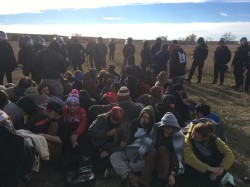
Others who have claimed they too were strip searched include: Standing Rock Sioux Chairman Dave Archambault II, a chief of a sovereign state, Dr. Sara Jumping Eagle, a pediatrician, Divergent actress Shailene Woodley, and Dale “Happi” Americanhorse Jr., the first activist to chain his arms to machinery with a sleeping tar dragon.
Bruce Ellison, a long-term criminal defense lawyer and legal team coordinator of the Lawyer’s Guild Mass Defense Committee, said the practice is nonsensical. Ellison and his team are also not allowed direct access to clients and must discuss the dozens of cases through glass windows and telephone conversations, which are being recorded, Bibens said.
“We have a lot of questions about that,” Ellison said. “When there are strip searches for lowest grade misdemeanors on the books in North Dakota – that certainly raises questions. We had one woman who was left naked in her cell overnight for the viewing of male guards.
“This seems unusual.”
Ladonna McLaughlin claims to have been left overnight naked in a cell, according to Bibens. Her family is preparing to sue Morton County.
“Where do we live?” Ladonna Allard, McLaughlin’s mother, said. “Is this the United States? This is a police state.” She was not ready to speak about the upcoming lawsuit, not until it is filed, she said.
“We are preparing litigation to address the violations that have occurred within the Morton County Jail,” Bibens said. She is a Santee-Dakota by birth, is the ground coordinator of the Red Owl Legal Collective, and also works as the camp’s attorney.
Most of the reported 126 people arrested Saturday have been spread to jails across the Peace Garden State, Bibens said. Costs of keeping a prisoner overnight is USD 100 for the Morton County Jail, times that by 269, then multiplied by how many nights, the costs add up.
“Hardly anyone is out,” Bibens said. “Parents are calling me from everywhere because they’re not allowing their 19-year-olds to bail out.” Officials around the Peace Garden State are now requiring cash only for bonds, are instituting special rules, and most activists arrested won’t get an opportunity for release until judges arrive at work Monday morning. “There’s an equal protection due process issue, if you’re related to the camps, then you get treated this way,” Bibens said.
“They’re not in any hurry to process any of our water protectors.”
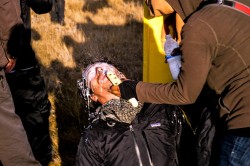
Some activists arrested are not being read their Miranda rights, Charlie Thayer, an activist who was arrested, said.
“Yeah that was me, and some others, we were held without bail,” Thayer said.
Additionally, the Red Warrior Camp, the activists’ most secure group, reported law enforcement shot down two drones with shotguns on Saturday. Morton County Sheriff’s Department reported “less-than-lethal ammunition” was used on a drone on Sunday charging a helicopter with a sheriff on board.
The helicopter pilot and passengers were “in fear of their lives” when the “drone came after us,” according to Morton County Sheriff’s Department press release. Two arrows were also fired at the helicopter, according to Kirchmeier.
On Sunday, Dewey reported nearly 700 Native Americans and activists enacted “their sovereign rights” proclaiming eminent domain along Dakota Access Pipeline route, effectively blockading Highway 1806 with hay bales, rocks, and tree stumps, on lands that once belonged to the Sioux under 18th century treaties. Tipis were erected. A sacred fire was lit. The land, according to Dewey, has been desecrated, and they are returning it back to the natural and spiritual balance.
"All tribes across the country witnessed this historical day, October 23," Dewey said. "This is a very special moment in Indian law as well, inherent rights have just been exercised. Our inherent rights to clean food, clean drinking water, medicine, clean air, all of those rights have just been practiced."
The move is called the "Last Stand" by activists before DAPL reaches the Missouri River.
In response, Morton County Sheriff’s Department blocked off Highway 1806 “due to a large group of protesters blocking the north and south bound lanes.” The barricade was dismantled later Sunday afternoon after law enforcement asked activists to take it down.
"Individuals trespassing on private property can't claim eminent domain to justify their actions," Kirchmeier said.
“Thirty Minutes of Terror”
Phelim McAleer, who identified himself as an Irish journalist to Morton County emergency personnel, is the director of the film FrackNation, a movie some say is part of the big oil campaign to debunk the harmful affects of fracking. McAleer traveled to the Standing Rock area last week to “get the truth about the story on both sides,” he said.
The first day he and two others received permission from Seven Council Fires Camp, or Big Camp personnel to conduct interviews, McAleer said. He waited until the second day to pull out the big questions.

“I asked them if they were being hypocritical,” McAleer said. “Because they were using automobiles to arrive at camp. And then a gentleman grabbed my microphone and dragged me across the field.”
His self-described “thirty minutes of terror” began.
Video of the incident taken primarily from inside a vehicle shows no violence, and yet McAleer insists that his life and property were threatened.
“I was scared, I really was,” McAleer said. He said he has reported news in Northern Ireland during the Troubles, and also in Eastern Europe when communism fell. “I’ve been around the block, a journalist for 30 years. It was very scary. There was a sense of lawlessness and anger that led to the unpredictability, feeding off their own energy, getting angrier and angrier. Blowing the horn seemed to excite them, it was escalating and that was the problem. There was no calming voice.
“I could see this getting ridiculously out of control.”
Their vehicle was surrounded. The driver, Magdalena Segieda, another producer of FrackNation, was afraid to put the car in park because the doors would unlock, according to Morton County Sheriff’s Department. Segieda called 911, and law enforcement arrived. McAleer, Segieda, and one other were eventually allowed to leave.
“They’re attacking us for asking questions,” McAleer said in the video.
“This is scary,” Segieda said in the video. “We want to leave.”
“It was a threatening and terrifying situation for the three journalists that were down there,” Kirchmeier said during a press conference. The video was taken from a low vantage point, and shows little outside activity.

McAleer retreated to Ireland after the incident, and isn’t pressing charges. He said Morton County Sheriff’s Department will investigate, and the department has already posted pictures of people involved in the incident on their Facebook page, asking for help identifying those involved. McAleer believes the video footage will speak for itself. “All I want to get is the truth of what’s happening, and I found that truth and it’s an ugly truth,” he said.
Camp authorities report that McAleer was read the rules of the area “one by one,” when he checked in. He was caught documenting children without permission from a parent or guardian, documenting the sacred fire that was off limits, and asking offensive questions of community members. When confronted, McAleer said he did not have a press pass, and that he did not need one, and when he pulled away in his vehicle he hit an unnamed activist, according to camp authorities.
In YouTube videos, McAleer described water contamination victims due to fracking practices are like bank robbers. “Why do you rob banks? Because, that’s where the money is. Why do you sue oil and gas companies? Because, that’s where the money is.”
McAleer, who has been called a “fake journalist” on big oil’s payroll, denied being supported by big oil companies. He is also known as a “professional character assassin,” and has been documented harassing movie stars and homeowners affected by Cabot Oil & Gas drilling in Pennsylvania. In a question and answer session after a showing of FrackNation in Pennsylvania, McAleer reported that the people with poisoned water, toxic enough to light on fire coming out of their taps, were lying.
“You can call it this, you can call it that, and maybe the truth is somewhere in between,” McAleer said. “And I know to use the word liar is a very strong statement, but they are liars. These are not stupid people, although they do a good job at looking like it. But they lied…
“Sorry. Where is the scientific evidence of your water being contaminated? If you don’t have any, how do you know you have any, you don’t know, you’re lying. You’re making it up, you’re scaring people.”
Closer to home, an April 27, 2016 study released by Duke University, funded by the National Science Foundation, and the Natural Resources Defense Council, and published in the Environmental Science & Technology magazine shows that accidental wastewater spills from “unconventional oil production in North Dakota have caused widespread water and soil contamination.” More than 9,700 wells have been drilled in the Bakken region of the Peace Garden State in the past decade, which led to more than 3,900 brine spills, primarily from faulty pipes, the report states.
The water studied in some spill sites was unsafe to drink, the study reported.
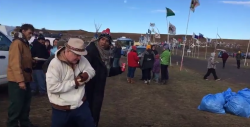
Political Pressure to Finish the Race
Senator John Hoeven R-N.D., met with the US Army Corps of Engineers last week to pressure the Corps into allow the final easement, a three-mile stretch of land leading up to the Missouri River, which would give DAPL the access it needs to send the pipeline under Lake Oahe.
“That means getting the Corps to approve the easement so construction can be complete and life can return to normal for our farmers and ranchers in the region, and for our law enforcement who are working very hard to protect lives and property,” Hoeven said in a press release. “We need to have this situation resolved.”
DAPL must hurry, according to Winona Laduke, executive director of the Native American environmental group Honor the Earth, and twice Ralph Nader’s Green Party vice presidential candidate, for some of their building permits expire in March.
Last week, the U.S. Corps of Engineers, representatives from the Standing Rock Sioux Tribe, state archeologists, and DAPL environmental team members coordinated a walk-through of a portion of the pipeline project, according to Morton County Sheriff’s Department.
“Morton County has been making an effort to bring representatives from the tribe, DAPL, and the state historical society for weeks,” Kirchmeier said. “This is very positive to see that all interested parties could together look at the sites in which they have had differing opinions of the historical significance. While there still may be differences, the conversation was positive and allowed all parties to better understand each other.”
Congressman Kevin Cramer R-N.D., participated. “I believe those of us on all sides of the Dakota Access Pipeline issue benefitted from walking together and sharing our expertise, experiences, and expectations,” Cramer said. “I hope this can help us establish a better understanding going forward. And, I am certain that after today the Corps of Engineers will feel confident it has the adequate affirmation to issue the final easement to complete the pipeline construction across the Missouri River at Lake Oahe.”
While Standing Rock Sioux leaders contemplate whether to move the winter camp to their own lands, one aspect of their fight has not changed. Their fight is not only today against DAPL, but it is a growing global resistance to big oil, and in many activists’ opinions, they are winning.
Even if the pipeline crosses the Missouri River.
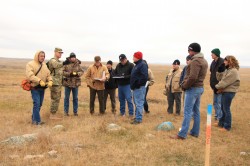
“As an activist I never cared about voting,” Iron Eyes said in a Facebook post. “I can see now how apathy about the political process allows establishment paid for politicians to stay in power like a revolving door. Big money pays for their campaigns, the politicians pave the way for their benefactors, the people feel disconnected, nobody cares, and we end up with politicians who suppress votes, militarize and embarrass our state…
“This is a great test for us. We need to be committed to peace on all sides.”
“We remain vigilant and organized,” Red Warrior Camp leaders posted on Facebook. “We’ll see you on the prairie.”
"I have the firm belief that we will stop a pipeline that carries 500,000 barrels of oil a day, and is 60 percent complete... we will stop it in its tracks," Dallas Goldtooth, a campaign organizer of the Indigenous Environmental Network, said in a speech.
September 19th 2024
June 20th 2024
April 18th 2024
April 18th 2024
April 18th 2024





__293px-wide.jpg)

By Josette Ciceronunapologeticallyanxiousme@gmail.com What does it mean to truly live in a community —or should I say, among community? It’s a question I have been wrestling with since I moved to Fargo-Moorhead in February 2022.…